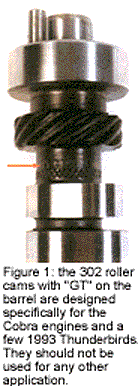
Ford 5.0L/302 "Cobra" Cams
Problem: Ford made a limited number of the Mustang Cobras with a "super-high-output" 5.0L in ’93, ’94 and ’95. They all had a unique roller cam (p/n F3ZZ-6250-A) that can be identified by the "GT" stamped on the barrel, right behind the distributor gear (see Figure 1, at right). This cam was designed to work with the specific combination of heads, intake, throttle body and injectors found on the Cobra engine, so it had different centerlines (115/121.5 for the Cobra vs. 116/115 for the H.O.), less overlap and slightly more lift.
This profile produced a smooth, stable idle, reduced hydrocarbon emissions, and gave the Cobra more low-end torque at the expense of some top end power. This cam was also used in some late ’93 5.0L Thunderbirds to "improve idle stability and reduce hydrocarbon emissions."
REBUILDER’S SURVIVAL TIP: Re-builders should throw this cam away unless they’re building a genuine Cobra engine. It doesn’t do a good job in the Mustang 5.0L because it doesn’t have the right profile for this combination, so it affects driveability and gives away some horsepower, too. It can also create problems if it’s used in any other 5.0L application except the 1993 Thunderbird that came with the unique, restrictive intake that was required to make the 302 fit under the hood of the Thunderbird.
Ford 351W With Excessive Oil Consumption
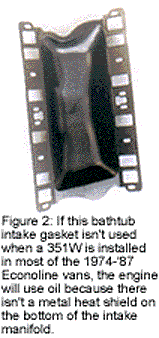
Problem: The 351 Windsor will have oil consumption problems if it’s installed in an Econoline van without the right intake gasket. The bottom of the intake manifold was too hot, even with the metal heat shield riveted to the bottom of the intake, so Ford left off the shield and used a special "bathtub" intake gasket to keep the oil off the manifold (see Figure 2).
This intake gasket was used on all of the 1974-’80 E150/250/350 vans and on all the 1981-’87 E250/E350 models with 8500 GVW or higher. It was discontinued when Ford put fuel injection on the 351W in 1988. This special gasket isn’t included in any of the gasket sets provided for this engine, but Ford lists it as a p/n D7UZ-94333-A, and most of the aftermarket gasket companies can supply it if you specify the right application.
REBUILDER’S SURVIVAL TIP: This problem may be old news to most rebuilders, but there are still plenty of these vans out there and lots of installers who don’t know the difference, so ask if the engine is going to be installed in a van every time you sell a 1974-’89 Ford 351W and, if so, make sure the customer has the right intake gasket for this application.
Ford 351 Windsor Cylinder Heads With Missing T.E. Passages
Problem: We have recently started seeing some E7TE head castings for the Ford 351W that weren’t drilled for the thermactor emissions (T.E., or A.I.R.) passages. After doing some research, we discovered that Ford plumbed the T.E. directly to the exhaust manifolds for some of the truck and van applications from 1990 through ’97, so some of the heads don’t need the T.E. passages.
There have been several applications that came with or without T.E. in the heads and a few that always came with it in the manifolds. However, there’s no way to know which version the customer has on most of them unless you ask him to tell you where the T.E. tubes go when he orders the engine. Rebuilders should be aware of a possible problem with the following applications:
1990-’94 Broncos came both ways;
1990-’93 F150/250/380 pickups came both ways;
1990-’93 E150/E250/E350 vans came both ways;
1994 F250/F350 pickups came both ways;
1995-’97 – All E250/E350 vans over 8501 GVW came with the T.E. plumbed to the exhaust manifolds;
1995-’96 – All F250/F350 pickups over 8501 GVW came with the T.E. plumbed to the exhaust manifolds.
REBUILDER’S SURVIVAL TIP: Ask the customer if the T.E. is plumbed to the heads or the exhaust manifolds before selling a 351W for one of these applications. Be sure to stock some T.E. plugs for the customer who discovers he needs them to plug the holes in the back of the heads after the engine is installed.
Chrysler 318/360 Blocks Cracked Around The Head Bolt Holes
Problem: Many of these blocks are cracked around the head bolt holes. Most thread repair inserts won’t work because the cracks extend out too far from the threads; some don’t work because they can’t take the torque required for a head bolt, and others leak coolant through the insert itself if you do try to use them. Some rebuilders "vee" out the cracks, weld them up, and deck the block, but that’s a time-consuming process that doesn’t always work out as planned.
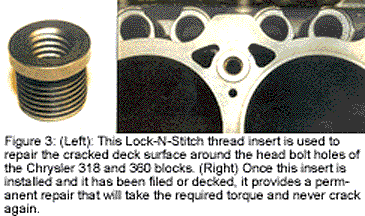
REBUILDER’S SURVIVAL TIP: Rebuilders can make a permanent repair by using the Spiralhook thread repair insert made by Lock-N-Stitch, Inc. (See Figure 3). It’s easy to install with a drill, a tap, a spot face tool and a file or a deck machine. They will take the required torque; they don’t leak coolant through the threads and they eliminate the crack forever. Call Gary Reed at 800-736-8261, and ask about the C51213I thread repair insert and tooling.
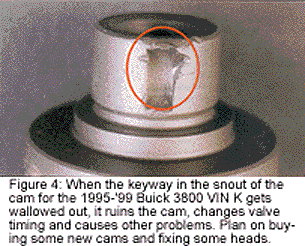
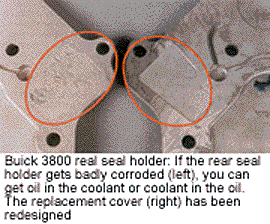
Chevy 3.1L/191 Cam Bearing Bores
Problem: Some of the later roller cam 3.1L blocks for the ’93-’94 Chevy VIN M are showing up with oversize cam bearing bores that appear to have been caused by spun cam bearings. If a new cam bearing is installed in a bore that has been damaged, it will spin in the block, cut off the oil to the cam, and cause an immediate failure.
REBUILDER’S SURVIVAL TIP: Inspect the cam bores in all of the late 3.1L castings (10137093/ 10191737/ 24504089/ 24504150/ 10224227) very carefully, paying special attention to the #2 bore that seems to be the most prone to failure. If the cam bore is oversize, there are only two choices: 1) You can either knurl the O.D. of the cam bearing to get enough press fit, or 2) you can junk the block.
Buick 3800 VIN K Cam Problems
Problem: Some of the 1995-’99 Buick 3800 VIN K cores are showing up with the keyway in the snout of the cam all wallowed out. When this happens, the cam gear rotates back and forth on the snout which not only ruins the cam, but also changes the valve timing and leads to abnormal combustion. We have seen valves that are bent because they collided with the pistons and heads that are cracked from the excessive heat.
REBUILDER’S SURVIVAL TIP: Watch for bad cams, bent valves, broken guides and cracked heads on these engines and anticipate the additional cost of parts and repairs when pricing them.
Buick 3800 VIN K Rear Seal Holder
Problem: The rear seal holder for the 1995 and up Buick 3800 VIN K also functions as the cover for the coolant passages and oil galleries on the back of the block. This can cause problems, because the coolant passages are pretty close to the oil passages, and the original covers (c/n 24503969) tend to corrode around the coolant holes. Once the gasket gets saturated with coolant and the cover ends up corroded around the coolant passages, you can end up with either water in the oil or oil in the water.
REBUILDER’S SURVIVAL TIP: Inspect these covers carefully and discard them if they are badly corroded. Replacing the early cover with the later, revised version (c/n 24507385) that has a more distinct ridge around the coolant holes to provide a better sealing surface for the gasket is cheap insurance. This updated cover is available from GM (p/n 24507386).
Doug Anderson is vice president of Grooms Engines, a production engine rebuilder located in Nashville, TN. E-mail Doug at [email protected].













